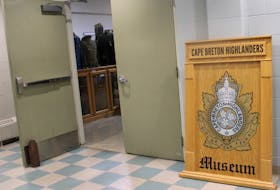PLYMPTON, DIGBY COUNTY, NS – As you crest the hill a short distance away before crossing into Plympton, Digby County, there it stands.
Well, what’s left of it.
If it’s a sunny day you can see the blue sky on the other side through the walls that were once covered in boards and windows. Now there’s just openings where those windows once adorned the walls.
And inside the wood craftsmanship that was hidden beneath finished ceilings is both massive and impressive.
This was a structure that was built to last.
Until now.
The Holy Cross Roman Catholic Church in Plympton, Digby County, closed years ago and now it is being taken apart.
After being temporarily closed at the end of 2013, its final service was held in July 2014 when a deconsecration took place to remove the blessing from the church and the land that the building sits on. At that time it was known that the building would be demolished one day in the future.
Tasked with this job now is Stan Atwell of Anything and Everything Demolition and Recycling. For the past six months he has been demolishing the structure by hand.
Yes, you read that correctly – by hand.

His company is looking to salvage and recycle as much of the building material as possible so it can be sold, reused and repurposed and most importantly diverted from the landfill stream.
“None of this goes to the landfill,” he says, pointing to some parts of the former church he is in the process of taking apart.
“There is stuff that is rotten that has to go to the landfill, but I’m up to an 80 per cent level of recycle,” he says. “Even boards that have no paint, no chemical on them, are made into kindling. But the stuff with paint we throw that out, we have to, it’s the law, which I still say is wrong, we can still chip it.”
On the day of this interview Atwell is doing the demolition work alone – like he does on most days. He does have a crew but his company is also involved with other recovery and salvage projects elsewhere in the province, including another church and two houses.
“I started this job and it was just going to be my project,” he says, pausing to look around where just he and this reporter stand. “And it’s actually going to work out to be, I think, just my project.”

He admits he hears complaints from some saying the dismantling is taking too long. On the other hand, others are appreciative that much of the structure is being salvaged, which is something that wouldn’t happen if an excavator came in and viciously tore the building apart.
Still, he says, eventually the heavy machinery will be needed.
“I’m taking her down all by hand, right straight down to the foundation. Once I get to the foundation I’m not going to manhandle that stuff. That’s when I’ll bring in an excavator to finish it,” he says.

In the past this parish did have a long history, serving the community for more than 175 years, although the church building Atwell is dismantling now is not the first one that originally stood here. The first church, a chapel, was built in 1838. In 1890 a new church was built and stood here until it was destroyed by fire in 1938. It took many years after that to build a new church.
This current church building is big, but the one before it was massive, says Atwell.
“You could have fit this one in that one,” he says.
However over the decades a dwindling number of parishioners and financial factors put this church – like many others – on a path to closure.
As Atwell goes about the arduous task of taking the building apart, the history of the building – and the importance of it in the past to the community – is not lost on him. He also says he works hard to keep the worksite tidy to ensure respect is shown to those buried in the adjacent cemetery.
Asked what stands out to him most about the building, Atwell says aside from its size, it is the way it was constructed.
Aside from the large arch inside the building, he says, “If you step back there is a massive A-frame system. It looks like a regular roof line, but every 10 feet there are massive A-frames. There’s a long steel rod that goes right down the dead centre of that. This thing is straight as an arrow over a hundred years ago and it still is.”
Or at least it will be until Atwell gets to that part of the job.








